| | |
- "Mandalore. Right turn off the Hydian Way. Can't miss it."
- ―Boba Fett
Mandalore was the fifth planet in the Mandalore system of the Outer Rim Territories, not far from the Hydian Way trade route. The homeworld of the multi-species cultural group known as the Mandalorians, the planet was known as Manda'yaim in the Mandalorian language, and was named after the legendary conqueror of the vibrant world, Mandalore the First. Mandalore the First's Taung warriors slew the indigenous mythosaurs and tamed the savage landscape, solidifying Mandalore's place as a powerbase and the center of Mandalorian space for millennia to come. Mandalore was covered in a rich natural landscape, largely unspoiled due to its sparse sentient population. The world was blanketed in lush veshok tree forests, dense jungle, sprawling hills and grassland well suited to farming, inhospitable deserts of white sand, and numerous rivers, lakes, and seas. It was also the only known world in the galaxy, with the exception of its moon Concordia, to possess the unique, nearly indestructible iron ore known as beskar, an element capable of withstanding blows from even a lightsaber.
An independent world ruled by the Mand'alor—the leader of all the Mandalorian clans, following the tradition established by Mandalore the First—the planet Mandalore found itself the ally and enemy of numerous galactic governments and groups throughout the years. Though largely abandoned by the early Mandalorian Crusaders, who continuously sought fresh conquests, Mandalore became the fallback point for many defeated Mandalorian Neo-Crusader warriors after the end of the Mandalorian Wars. With the rise of the pacifist New Mandalorian faction and their efforts to reform Mandalore's warrior ways, distancing themselves from the violent past after the disastrous events that lead to their formation, Mandalore was accepted by the Galactic Republic and was known as New Mandalore throughout the isolationist society that the New Mandalorians created. Originally neutral during the Clone Wars, after the New Mandalorian capital fell to the machinations of the Death Watch, the pacifist faction's influence dwindled. Later, when Mandalore the Resurrector came to power, the planet broke from the Republic and joined the Confederacy of Independent Systems against the oppressive Coruscant regime, only to come under the heel of the Galactic Empire following the end of the Clone Wars.
With the fall of the Empire, Mandalore began a steady period of recovery up until the Yuuzhan Vong's invasion of the galaxy, and the devastation the extragalactic invaders wrought upon Mandalore. The resilient world did not yield to the Vong's attempt at destruction, however, and by the Second Galactic Civil War, Mandalore was in the midst of a prosperous resurgence brought on by the discovery of fresh lodes of beskar iron that had been exposed during the Yuuzhan Vong attack. Mandalore suffered an attack by elements of the Imperial Remnant loyal to the Sith Lord Darth Caedus near the war's end, yet persevered, continuing to grow and developing ties with the Verpine and the Galactic Alliance. Under the leadership of Mand'alor Yaga Auchs, the Mandalorians withdrew from the Sith–Imperial War and remained on Mandalore throughout the Second Imperial Civil War, focused on bettering their world.
Description[]
- "I've never seen Mandalore. What's it like?"
"I'd like to say it's paradise, but it's as rough as a bantha's backside, and half as pretty." - ―Etain Tur-Mukan and Kal Skirata
Mandalore was located in the region of the galaxy known as the Outer Rim Territories,[1] near the Hydian Way trade route,[4] where it occupied the fifth orbit of the Mandalore sector's cognominal Mandalore system, between the orbits of Kalevala and Mandallia. It sat at the end of the hyperspace lane known as the Mandalorian Road, an ancient route that connected Mandalore with the planet Corsin in the Inner Rim. A terrestrial world spanning nine thousand, two hundred kilometers in diameter,[1] Mandalore possessed standard gravity[12] and two moons,[1] including the one time mining base and agricultural center, Concordia.[2] Unique to Mandalore and the Concordia moon was beskar iron ore, a nearly indestructible metal capable of withstanding blows from even a lightsaber, and used by Mandalorian metalsmiths to forge armor, weapons, and starships.[3][14] A year on Mandalore comprised three hundred and sixty-six days, and each day was made up of nineteen hours.[1] Mandalore possessed a breathable atmosphere, and a climate that varied by region.[12]
Before the rise of the Mandalorians, Mandalore was dominated by the gigantic mythosaurs. The enormous beasts were said to rival cities with their size,[15] but when the Taung warriors arrived on Mandalore, they set to slaughtering the creatures as part of their conquest of the new world, leaving only their massive skeletons behind to bleach in the light of Mandalore's sun.[1] Native veshok trees covered much of Mandalore's northern hemisphere,[12] such as the Olankur region of its northern continent,[6] forming a dense forest that stretched nearly as far as the polar ice caps.[12] Winters in the north of Mandalore often saw significant snowfall, and bitter cold temperatures.[9] The herbivorous animals called shatuals could be found living within the veshok forests, as could the intelligent, six-legged strills that preyed upon them for food.[12] Tall, long-lived galek trees with their silver-colored leaves were also a common sight on Mandalore, as were the golden amber ferns that grew in and around galek groves.[15] Wild mushrooms were known to grow on and around Mandalore's trees,[16] and a number of a serpentine rawl could be found in the Mandalorian wild,[8] transplanted from their natural habitat on Naboo.[17]
Forty-five degrees north of Mandalore's equator, atop a flat granite hill nestled along a bend in the kilometers-long Kelita River, sat the city of Keldabe.[4] Since at least 3960 BBY, Keldabe had served as the capital of Mandalore, and the center of government for much of Mandalorian space.[1] However, following the foundation of the New Mandalorian faction, the reformist sect declared the domed city of Sundari, located in one of Mandalore's expansive[18] and inhospitable[19] white-sand desert regions, to be their capital.[13] Positioned out on the flat desert plain,[2] Sundari was constructed over a large, active beskar mine,[20] surrounded by sand and the giant cube-cities[2] built by the innovative builders of the New Mandalorian people who rejected the ways of Mandalore's warrior clans.[18] Keldabe, however, found itself surrounded by woodland and the waters of the Kelita,[4] along with gentle green hills that spread outward to fertile grassland the more agriculturally-minded Mandalorians took advantage of for farming.[3] Keldabe boasted two of Mandalore's most renown landmarks, the hundred-meter-tall tower of the MandalMotors company headquarters,[4] and the Oyu'baat hotel and tapcafe, one of the oldest establishments on the planet.[12] With no formal palaces or offices among the warrior clans, the Oyu'baat was also an informal meeting place for the Mand'alor and clan chieftains, making it the unofficial center of Mandalore's clan-based government until 40 ABY, when this role was shared by the newly established community building, MandalMotors Hall.[3]

Traditional Mandalorian dwellings called vheh'yaime could be found across Mandalore.
Other cities and settlements littered Mandalore's surface, including the Keldabe suburb of Bralsin near the Kelita valley,[7] and the small town of Shuror.[6] Most of Mandalore's settlements were built within a heavy fortification that contributed to the ease with which they could be defended from potential invaders. An example of such a settlement was the hill-fort town of Norg Bral,[15] home to several members of Clan Bralor.[3] The water supply to these settlements was provided by lengths of pipelines and deeply-dug wells, often making use of both to ensure the certainty of available water.[7] Further south and away from Keldabe, Mandalore's tropic regions boasted warmer weather and was where varos fruit could be found growing.[6] Roads on Mandalore were rarely straight, designed so as to grant Mandalorians the advantage in ambushing and pinning down hostiles as they traveled.[3] Traditional dwellings known as vheh'yaime—made from wood, woven vines, and matted mud—were a common choice for the homes of Mandalore's warrior clans[10] and numerous vheh'yaime of varying sizes could be found across Mandalore.[7] Due to the varied nature of the different species and backgrounds that comprised the greater Mandalorian people,[3] the architecture of Mandalore differed greatly depending on the region and that area's particular inhabitants, from towers of transparisteel[13] and granite, to durasteel,[6] and even tree-bound abodes.[7]
History[]
Early history[]
- "After being driven from ancient Coruscant, the Taungs relocated to Roon and then wandered the Outer Rim, leaving hints of their passage in various species' chronicles and histories. But they attracted little notice until they conquered Mandalore around 7000 BBY."
- ―Vilnau Teupt

The Taung conquerors of Mandalore
Mandalore was once a wild and savage world,[1] uninhabited by sentients, where the dominate life forms were the gigantic mythosaurs.[14] That all changed with the arrival of the Taung. Forced from the planet Coruscant in the Core Worlds long before the foundation of the Galactic Republic by the Human Battalions of Zhell, the Taung fled to Roon, before arriving at the Outer Rim world they came to call Mandalore circa 7000 BBY. In honor of their leader, Mandalore the First, the Taungs named the world Manda'yaim,[1] or "home of the Mand'alor,"[22] which was later transliterated as Mandalore in Galactic Basic Standard. Similarly, the Taungs recast themselves as the Mandalorians,[23] or Mando'ade: "sons and daughters of Mandalore."[24] The newly branded Mandalorians set to taming their new world, and in the process slaughtered the enormous mythosaurs, leaving only their skeletons behind.[1] Mandalore became the home of fierce clans of masked Taung warriors led by a single warlord who always adopted the name Mand'alor,[15]—a title which meant "sole ruler" in the Mando'a language[22]—after Mandalore the First. But a single new planet was not enough for the Mandalorian Taungs who craved fresh conquests, and though Mandalore remained the center of what was to become Mandalorian space, it was largely abandoned by the time of the Great Sith War in 3996 BBY, as Mandalore the Indomitable led the clans outward as Mandalorian Crusaders to bring new star systems under Mandalorian control.[1]
The attacks of the Crusaders only intensified as time passed,[1] and though Mandalore the Indomitable fell in battle while engaging the Republic's military with the Brotherhood of the Sith[25] Mandalore the Ultimate quickly replaced him. The new Mand'alor, believing the fabled "Great Last Battle" to be at hand,[14] turned back to the planet Mandalore at the behest of his advisor, Cassus Fett, for his new army. There on the Mandalorian homeworld existed the unorthodox warrior sect known as the Neo-Crusaders. These warriors deviated from the Crusader norm by wearing identical suits of armor and implementing a more rigid chain of command. Following Fett's advice, Mandalore the Ultimate made the Neo-Crusaders the backbone of his new army, and by the time he had instigated the Mandalorian Wars with the Republic, Neo-Crusaders comprised most of Mandalore's warriors.[26] As the Neo-Crusader army conquered more and more worlds, the planet Mandalore became the center of a Mandalore sector that stretched across the majority of the galaxy's northern quadrant.[1] Mandalore the Ultimate's endeavors were doomed to failure, however, and when the Jedi Knight Revan slew the Mand'alor in single combat at Malachor V, the Mandalorian Wars were brought to a swift end. With no purpose, many defeated Mandalorians turned to lives as mercenaries, bounty hunters, and even bandits, while others returned home to Mandalore.[27]
Thousands of years later, during the period known to history as the Republic Dark Age, an epidemic of the Candorian plague spread across the galaxy. One of many worlds struck by the plague,[21] Mandalore was devastated by the deadly illness.[28] Furthermore, a weakened Mandalore sector had come under attack by raiders from the lawless regions of space that surrounded it to such a degree that Mandalorian vessels were forced to form defensive caravans in order to move about. When the veteran mercenary Aga Awaud returned home to Mandalore 1058 BBY to discover most of his clan had perished to the plague and Mandalorian space was under siege from outlaws, it wasn't long before he took up the then-vacant role of Mand'alor. In a move to stem the chaos before him, Awaud began a movement that came to be known as the Return, calling upon Mandalorians living throughout the galaxy to rally to the defense of Mandalorian space. Awaud's efforts were ultimately successful, allowing Mandalore to not only survive the tumultuous era, but flourish, becoming a regional industrial power and a symbol of much-needed stability in the galaxy's Outer Rim Territories.[21]
War and reformations[]
- "Mandalore's violent past is behind us."
- ―New Mandalorian Prime Minister Almec
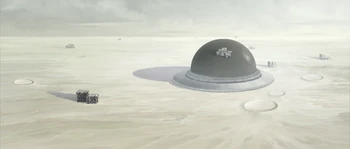
In one of Mandalore's white-sand deserts sat the New Mandalorian capital city of Sundari.
In the years following the Galactic Republic's defeat of the Brotherhood of Darkness at Ruusan, and the subsequent Republic reformation that marked the end of the New Sith Wars, the Mandalorians on Mandalore pushed to remake themselves into a more technologically adept and more rigid, militant society. The rise in Mandalore's militancy so soon after the devastating war with the Sith alarmed both the Republic and its Jedi protectors,[1] and while several clan leaders urged Mandalore to make peace and join with the Republic, they were summarily shouted down. Unwilling to suffer through a second war with the Mandalorians, in 738 BBY the Jedi led a Republic strike force in a brief and overwhelming conflict known as the Mandalorian Excision that brought devastation to the Mandalore sector,[21] and transformed parts of Mandalore[18] into inhospitable[19] deserts of white sand.[18] Out of this disaster arose a pacifist sect calling themselves the New Mandalorians; the reformist political faction formed from the remnant of the pre-Excision peace movement renounced violence and the warrior codes of Mandalore's past,[21] in what they believed to be an effort to save Mandalore and survive in a hostile galaxy. Instead, the New Mandalorians preached peace, neutrality, and tolerance. They used their talents as builders and inventors to create grand cube cities in Mandalore's desert, forging a new society isolated from Mandalore's warrior clans,[1][18] on the planet they deemed "New Mandalore."[29]
The New Mandalorians' dedication to peace, their love of advanced technology,[18] and the wealth of beskar afforded to them by Sundari's mines,[20] allowed for the pacifist sect to claim ascendancy over the scattered, squabbling warrior clans on Mandalore for centuries,[1] and for the first time in the planet's history[15] Mandalore was welcomed by the Republic, and offered representation in the Galactic Senate.[2] In spite of this, a significant number of Mandalorians continued to live much as they had for generations, continuing their warrior traditions in locations such as Keldabe.[12] These traditional practitioners came to be known as "Old Mandalorians,"[20] the Aka'liit, or in some cases, the "Mandalorian Faithful." Among many of the so-called Faithful, the New Mandalorians were, in turn, deemed the Faithless, for turning their backs upon the Mandalorians' cultural heritage.[30]
The year 60 BBY[27] saw the ascension of Jaster Mereel to the role of Mand'alor. Born on the planet Concord Dawn, Mereel served as a member of the world's law officers known as the Journeyman Protectors until his strong moral code drove him to kill a corrupt superior officer; Mereel was exiled from Concord Dawn as punishment for his own crime, and joined the Mandalorian culture soon after. Having noticed many Mandalorians' dissatisfaction with the wide-spread savagery that had become prevalent in certain warrior circles, Mereel hoped to hold the Mandalorians to a higher standard of behavior. As Mand'alor, Mereel instituted the Supercommando Codex, a new behavioral guideline influenced by Mereel's own moral ideals, in which Mereel decreed that any Mandalorians who wished to fight would be merely highly-paid soldiers, and should conduct themselves as honorable mercenaries. Mereel was opposed in this effort by a number of amoral Mandalorians who resented Mereel for his attempts to rein in their lifestyles of unaccountability.[14] These malcontents rallied to a barbaric[31] Mandalorian soldier named Tor Vizsla,[1] and therein formed a splinter group known as the Death Watch with Vizsla as their leader,[14] a Secret Mandalore in opposition to Mereel, who pledged to destroy the New Mandalorian regime,[30] and return the Mandalorians to their ancient roots as conquerors and raiders, with the ultimate goal of instigating another war of galactic conquest.[14] Around this time, Chieftain Nam Beroya departed Mandalore with numerous members of Clan Awaud, having grown disillusioned with the divisive politics that were overtaking Mandalore, instead seeking a simpler way of life for him and his clan.[20] Civil war soon broke out between the Death Watch and Mereel's loyal supercommandos—now calling themselves the "True Mandalorians"—while the New Mandalorians kept to their ideals of pacifism and non-violence, rejecting both groups and remaining out of the conflict.[1]
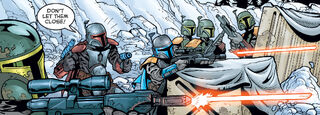
The True Mandalorians fought to keep Mandalore from the Death Watch
In spite of its philosophical and ideological importance to the Mandalorian people, the war had was fought between two relatively small factions of soldiers, in what was seen by some as little more than a common power struggle. Mandalore's full-time army was swallowed by the conflict, along with several prominent clans, but it scarcely touched Mandalorians living off-world, even those in the surrounding Mandalore sector.[6] Jaster Mereel was eventually killed by Tor Vizsla on Korda Six, though command of the True Mandalorian army and the role of Mand'alor was taken up by Mereel's surrogate son, Jango Fett. Waged on several non-Mandalorian worlds, the tide of the civil war slipped back and forth in favor of either side until the disastrous battle on the planet Galidraan, where the schemes of the Death Watch allowed for a misled Jedi strike team to kill the True Mandalorians, all but Jango Fett, who was taken into custody by the Jedi and delivered to the Governor of Galidraan, who subsequently sold Fett into slavery. Though Fett was able to escape his unjust captivity and take his revenge on Vizsla,[31] his losses and time in captivity made Fett a bitter man, and though he was still Mand'alor, he grew distant from the Mandalorian people.[12]
With opposition from the True Mandalorians removed, the Death Watch sought to take advantage of growing hostilities on Mandalore between feuding clans with their loyalties divided. As open war erupted, Death Watch made attempts to garner support from the populace to overthrow the New Mandalorians, but the bloody conflict that became known as the Great Clan Wars harmed their cause as much as any other, and the splinter group suffered notable losses to the fighting.[30] This second civil war divided clans and pitted family members against one another,[13] leading to the death of a great many Mandalorians,[32] and seeing further devastation incurred to Mandalore in addition to the scars of the centuries-old Excision. The Death Watch ultimately failed to unseat the New Mandalorian regime, while the majority of the chieftain warlords responsible for the conflict either joined the New Mandalorians, weary of war, or went into exile on Mandalore's moon, Concordia.[13]
Clone Wars[]
Peace under fire[]
- "Your peaceful ways have paid off. Mandalore has prospered since the last time I was here."
"Not everyone on Mandalore believes that our commitment to peace is a sign of progress." - ―Jedi Knight Obi-Wan Kenobi and Duchess Satine Kryze, ruler of the New Mandalorian people

The tranquil Peace Park was located deep within the city of Sundari.
As the Clone Wars broke out in 22 BBY at Geonosis, between the Galactic Republic and the droid army of the Confederacy of Independent Systems, Jango Fett was killed in battle with Jedi Master Mace Windu, but not before he was chosen ten years earlier to be the template for the clone troopers of the Republic's Grand Army, secretly grown from his DNA on Kamino by Kaminoan cloners. With Fett gone,[33] Mandalore's role in the war was defined by the New Mandalorian government. By this time, Mandalore and its sector were represented in the Republic senate by Senator Tal Merrik of the neighboring world, Kalevala.[15] Under the leadership of Duchess Satine Kryze—who had been named Mand'alor of the New Mandalorians at the conclusion of the Great Clan Wars[30] in opposition to Jango Fett,[12] whom the New Mandalorians refused to recognize[21]—Mandalore joined the Council of Neutral Systems,[2] a political coalition comprised of close to fifteen hundred star systems with desires to remain neutral in the Clone Wars. Despite the planetary neutrality established by the New Mandalorian government,[32] several Mandalorian mercenaries took work individually and in groups for either side during the conflict.[9]
It was at this point in history that the Death Watch made their return to the galaxy at large.[2] Having fractured and gone into hiding under the Mandalorian principle of ba'slan shev'la, or "strategic disappearance," following the death of Tor Vizsla[6] and the end of the Great Clan Wars,[13] Death Watch had begun to reassemble under the command of another member of the Vizsla clan, Pre Vizsla. Acting as governor of Mandalore's moon, Concordia, Vizsla kept up a public persona as the loyal friend and ally of Duchess Kryze. But in secret, Vizsla despised Kryze, and hated both the pacifist New Mandalorians, and their government's power over Mandalore.[18] In the aftermath of Jango Fett's death,[33] Vizsla believed that he was carrying on the role of the traditional Mand'alor,[34] and to that end he began assembling a new Death Watch army at a secret base within the abandoned beskar mines of Concordia. Allying with the Confederacy of Independent Systems and its leader, Count Dooku of Serenno, Vizsla dreamed of destroying the New Mandalorians and conquering Mandalore.[18] He sent a Death Watch operative to attack a Republic cruiser, and disseminated rumors of Mandalore raising an army for the Confederacy, drawing the attention of the Jedi Council who dispatched Jedi General Obi-Wan Kenobi to Mandalore. While meeting with Duchess Kryze in Sundari's Peace Park, the park's Memorial Shrine was bombed by a member of the Death Watch, the latest in a series of escalating attacks.[2]
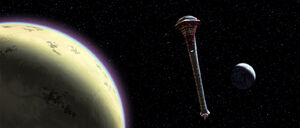
Duchess Satine's personal starship, the Coronet, departing from Mandalore
Fearing the apparent threat the Death Watch posed to Mandalore and beyond, the Republic senate drafted a resolution to deploy a Republic military force to Mandalore in order to defend against the Death Watch, a resolution championed by Supreme Chancellor Palpatine.[35] This was the plan of Count Dooku all along, intending to make the Republic appear as an antagonist invasion force, which would in turn cause the people of Mandalore to rally behind the Death Watch as liberators.[2] In an effort to keep this outcome from occurring and making Mandalore a military target, Duchess Kryze, Senator Tal Merrik, and a retinue of other sympathetic senators traveled aboard Kryze's personal starship to Coruscant, where the New Mandalorian leader intended to plead her position to the Galactic Senate. On route, Senator Merrik was revealed to be a traitor to the New Mandalorian cause and a secret ally of the Death Watch; he attempted to have Kryze murdered, only to be exposed and killed, himself, by one of the Duchess's Jedi protectors. With Merrik dead, Mandalore was left without a senator,[32] and Kryze took it upon herself to personally speak before the Republic senate. Though manipulation within the Republic government initially turned the vote against Kryze—and the Death Watch continued to make attempts on her life, even on Coruscant—the Duchess was ultimately able to convince the Galactic Senate with the aid of posthumous testimony from the New Mandalorian Deputy Minister, Jerec, that the New Mandalorian government would be able to combat the Death Watch independently and effectively, without the need for Republic intervention.[35] Death Watch was eventually exiled from Mandalore, and forced from the surrounding system.[36]
The senate elected to allow Mandalore to uphold its neutrality in the war effort, quashing the hopes of Pre Vizsla and the Death Watch to take control of the planet,[35] but that victory came at a price: Duchess Kryze's actions were negatively perceived by elements of the Republic government, and as a neutral state, Mandalore was viewed as a Republic outsider. Trade routes to Mandalore were closed, leaving the world to its own resources without aid from the interstellar government, and forcing the New Mandalorian people to invest heavily in black market dealings in order to obtain much-needed supplies. This foray into the world of illegal goods had the unintended side effect of rampant greed and corruption spreading through the New Mandalorian government and police force. To help alleviate these tensions, Duchess Kryze invited Senator Padmé Amidala to Mandalore for a diplomatic visit to discuss the crisis. It was during Amidala's stay on Mandalore that the corruption within the New Mandalorian customs department allowed for a large number of New Mandalorian school children to be poisoned by slabin-laced tea that had been imported by smugglers. Kryze and Amidala tracked[11] the Moogan smugglers[37] responsible to a warehouse at the shipping docks of Sundari, and following a brief shootout between the smugglers and several officers of the Mandalorian guard, the operation was dismantled. Kryze later provided the poison antidote to the hospitalized children,[11] and not long after, it came to light that the New Mandalorians' own Prime Minister, Almec, was behind the black market conspiracy. At this revelation, Almec was removed from office and summarily imprisoned.[38]
Nevertheless, Mandalore was selected as the location for diplomatic talks between select members of the Republic Senate and the Separatist Parliament. In the Royal Palace of Sundari, parties of diplomats from each government met to discuss peace and an end to the Clone Wars. These peace negotiations soured with the intervention of the young Separatist Senator Lux Bonteri, whose accusation of wrong-doing toward the Confederate leader, Count Dooku, brought the proceedings to a break down.[39]
The New Mandalorian coup[]
- "Listen, Duchess. Do you hear the people? They cry out for change. Your weak-minded rule of Mandalore is at an end."
- ―Pre Vizsla, speaking to Duchess Satine Kryze
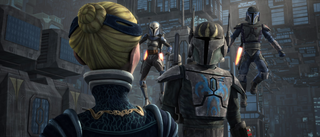
Death Watch returns to Mandalore, publicly offering protection while secretly seeking control
Nearly two years since their last attempt to wrest power from the New Mandalorians, the Death Watch returned to Mandalore at the same time Sundari came under attack by a contingent of criminals known as the Shadow Collective.[13] As the foot soldiers of Black Sun, the Pyke Syndicate, and the Hutt Cartels terrorized Sundari, Death Watch presented themselves to the New Mandalorian people as saviors. In truth, however, Death Watch was in collusion with the Shadow Collective, having struck a deal with the criminal alliance's leaders, the Sith Lord Darth Maul and his apprentice Savage Opress, wherein the outlaws would sow chaos and disorder throughout New Mandalorian territory, only for Death Watch to appear to come to the people's rescue and win public favor. Across Sundari and the New Mandalorian-held cities of Mandalore, Death Watch beat back and arrested the criminal members of the Shadow Collective in staged battles, making a display of the ineffectiveness of Duchess Satine Kryze's leadership, before finally confronting the New Mandalorian leader in her palace throne room. With the will of the people turned to support him, Death Watch leader Pre Vizsla deposed Kryze, imprisoning the duchess and her council of ministers,[40] before finally installing himself as the new Prime Minister and claiming the title of Mand'alor of the New Mandalorians.[13]
His goals met, Vizsla turned on his Sith allies, imprisoning both Maul and Opress in the same facility where the New Mandalorian government's officials had been incarcerated. Unbeknownst to Vizsla, Darth Maul had anticipated and planned for such a betrayal, allowing himself to be captured so that he might find a more malleable replacement for Vizsla as puppet ruler of the New Mandalorians. Within the prison, Maul came across the former Prime Minister Almec, who was willing to side with the Sith in order to escape prison and regain his lost standing. Breaking free of their confines, Maul stormed the Royal Palace with his apprentice and Almec in tow, where he challenged Vizsla to single combat for the right to rule.[40] Bound by honor to the ancient warrior codes he sought to reinstate,[13] Vizsla battled Maul in a furious duel through the throne room, finally losing to Maul when the Sith Lord decapitated him.[40]
Though Maul had won leadership of Death Watch in accordance with the old ways the group venerated, a unit of soldiers loyal to Vizsla's lieutenant Bo-Katan refused to concede leadership to a non Mandalorian.[13] The breakaway group fled the palace amidst a heated firefight, and moved to rescue the imprisoned Duchess Kryze. While Kryze was apprehended shortly after the Death Watch renegades' escape attempt, she had succeeded in contacting the Jedi Temple with news of the coup, bringing Jedi Master Obi-Wan Kenobi to Mandalore on a mission to save Kryze shortly thereafter. Kenobi's rescue attempt fared no better than Bo-Katan and her troops', and Kryze was slain by Maul in order to cause her former lover, Kenobi, anguish. In spite of their inability to rescue the duchess, Bo-Katan and her warriors freed Kenobi from Maul's Death Watch loyalists, and rushed the Jedi Master out of Sundari and off of Mandalore in the middle of a battle between the two Death Watch factions. Concurrently, the Dark Lord of the Sith Darth Sidious arrived on Mandalore, upon having sensed the whereabouts of his one-time apprentice, Darth Maul. In the Sundari palace, Sidious faced off against Maul and Savage Opress in a duel to settle a breach of the Sith Order's Rule of Two, eventually killing Opress and subduing Maul for his own future purposes.[41]
The balance of power shifts[]
- "So, who's to know whether Jango had more than one son or not, or even how old he is? Come on now, Spar, it's time to be doing your bit for Manda'yaim. You don't have to lift a finger. Just act like Fett's heir while we sort ourselves out, so everyone knows we're still in business."
- ―Fenn Shysa, speaking to Spar
The New Mandalorians were not the only citizens of Mandalore to fall upon hard times during the Clone Wars. Having been marginalized by the Republic, much of Mandalore had grown impoverished and in need of funds. This was the climate into which stepped Spar—the former Alpha-class ARC trooper who fled Kamino and deserted the Grand Army before the start of the Clone Wars—when he arrived on Mandalore.[14] Encouraged by clan chieftain Fenn Shysa, who spread rumors that Spar was the son and heir of Jango Fett in order to capitalize on Fett's reputation as a Jedi killer,[12] Spar took up the vacant position of Mand'alor. Determined to rebuild a new army of Mandalorian supercommandos in the image of the fallen True Mandalorians, Spar found many willing recruits among the ranks of the local police, and his growing Mandalorian Protector army even attracted nearly a dozen former members of the Death Watch.[23]
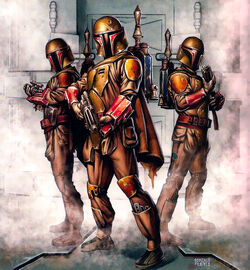
The Mandalorian Protectors were formed by Spar on Mandalore
Spar and the Protectors won control of Mandalore, and Spar took the sobriquet "Mandalore the Resurrector" as an indication that the traditions of the warrior clans had regained supremacy.[1] The new Mand'alor brought the planet over to the side of the Confederacy of Independent Systems, viewing the Republic as a corrupt oppressor, and seized the production facilities of MandalMotors in Keldabe for the Confederacy's exclusive use.[14] Once Mandalore was on the side of the CIS, the ranks of Spar's Mandalorian Protector army were supplemented by one thousand BL-series Battle Legionnaire droids, partially designed by Fenn Shysa,[23] and supplied by the Confederacy's droid foundries.[42] Setting out from Mandalore, the Mandalorian Protectors entered into the Clone Wars as a Confederate shock force. Confederacy commanders called upon the Protectors to deal with stubborn Republic opposition that their mass-produced battle droids could not overcome; once the Protectors arrived on the battlefield, the enemy was often defeated in under a day.[23]
They stormed planets such as New Bornalex, New Holstice, Null, and Zaadja,[23] until finally being assigned to capture Senator Padmé Amidala on Norval II, a task given to them by the shadowy Darth Sidious on behalf of the CIS. Once on Norval II, the Protectors were overwhelmed in a surprise Republic ambush orchestrated by Sidious' alter-ego, Chancellor Palpatine. Nearly all of the Protectors' Battle Legionnaire droids were destroyed and the Mandalorians killed, all except for Fenn Shysa, Tobbi Dala, and Mand'alor Spar himself. After the devastating defeat,[14] the three returned to Mandalore,[12] where a shell-shocked Spar stepped down from being Mand'alor,[14] though Shysa made repeated unsuccessful attempts to get the ex-Mand'alor to resume his post.[12]
As the Clone Wars came to an end, the Galactic Republic was transformed into the Galactic Empire, under the newly crowned Emperor Palpatine.[43] Despite Mandalore's role in the Confederacy of Independent Systems late in the war, the fledgling Empire granted the planet amnesty, and even offered Mandalorians paying mercenary work[12] as part of the Jedi purge Palpatine had initiated.[6] The Imperials were also interested in purchasing land on Mandalore where they could establish a garrison as a base of operations for the surrounding quadrant. The clans met, and finding the Empire's offer to be generous, they agreed to a temporary lease of land near Keldabe.[12] The Imperials moved into what became known as the City of Bone, a failed amusement park designed by an enterprising Mandalorian to look like a giant mythosaur skeleton, in the hopes of attracting adventure tourism to Mandalore.[6] At the same time as the Empire began to move onto Mandalore, Fenn Shysa acquiesced to popular opinion and accepted the position of Mand'alor.[12]
During this time, Mandalore became a haven for numerous clone troopers of the former Republic, who had deserted from their positions in the Grand Army for the promise of a life of freedom. This underground movement was centered around Kyrimorut, home of the former Cuy'val Dar clone trainer Kal Skirata and his clan.[12][7] However, clone deserters were not the only increased presence on Mandalore during this period. In the aftermath of the New Mandalorians' fall and the dissolution of the Shadow Collective, elements of Black Sun moved to fill the void the fleeting criminal contingent had left. The syndicate established a known presence on Mandalore's moon, Concordia, and Tyno Fabris—lieutenant to the Black Sun Vigo Xizor—took up residence in Keldabe, where the Arkanian gangster worked out of an office in the Oyu'baat cantina. Around 18 BBY, the Jedi Knight Jax Pavan traveled to Mandalore in search of information on the whereabouts of a friend taken by the Empire. He met with Fabris at the Oyu'baat on multiple occasions, eventually acquiring the information he sought after making a deal with Fabris' superior, Vigo Xizor.[44]
Imperial occupation[]
- "Our homeworld had been overrun by slavers sanctioned by the Empire, an' they'd turned Mandalore into a conscription center fer slaves needed to work the fact'ries, farms an' mines what kept the Imperial war machine runnin'. That's when me an' Tobbi went underground to form an outlaw band. An' we been fightin' to give Mandalore back to the Mandalorians ever since!"
- ―Fenn Shysa
Though the Empire's relationship with Mandalore was cordial at first—offering large sums for mining rights in the beskar-rich Tokursh region of the planet, and brokering starship contracts with MandalMotors[6]—by the start of the Galactic Civil War, the Imperial grip on the Mandalorian homeworld had tightened harshly.[14] Aided by elements of the reborn Death Watch, operating on Mandalore under the leadership of Lorka Gedyc,[6] Imperial advisers were installed on MandalMotors' executive board, accumulating power in the name of the Empire. One such adviser, known as the Suprema,[14] confiscated the traditional armor of Mandalore's citizens,[23] and instituted a massive slaving operation that sent a large portion of Mandalore's population into chains.[14] These slaves were used by the Empire to operate factories contributing to the Imperial war effort, and to aid the Imperials' endeavors[16] to strip-mine Mandalore of valuable beskar ore.[3] The Empire also established an Imperial Academy on Mandalore.[20]
It was during this time that the criminal organization run by the crime lord Tyber Zann engaged in a mission to Mandalore, successfully kidnapping the being known as the "Supreme Strategist." His pirates were also responsible for several raids on facilities owned by Mandal Hypernautics, carried out in order to convince the Mandalore-based company to supply his organization with their ships and war machines.[45]
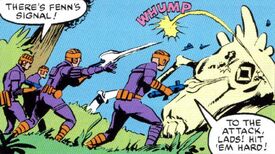
Members of Fenn Shysa's Mandalorian Protectors assault the Imperials within the City of Bone.
Against the Imperial occupation, Mand'alor[6] Fenn Shysa covertly trained a new iteration of the Mandalorian Protectors. Without the widespread availability of Mandalorian armor or weaponry, Shysa instructed his new army in guerrilla tactics as an insurgent force.[23] Shysa and Tobbi Dala,[16] the only other surviving member of the original Mandalorian Protectors beside Spar,[14] led numerous raids on slaver operations, rescuing Mandalorian slaves from their Imperial captors, and disappearing before the Empire could strike back, tactics which made use of the Protector's familiarity with Mandalore's dense jungles.[23] However, the success of the Protectors made Shysa a target for an Imperial bounty, and during the late years of their campaign against the Empire's presence on Mandalore, Dala was captured by the Suprema. When the bounty hunter Dengar came to Mandalore to capture Shysa for the reward on the Mand'alor's head, he was instead taken captive by the Protectors and negotiations were made to exchange him for the release of Dala.[16]
Shortly after, Princess Leia Organa of the Rebel Alliance also traveled to Mandalore, hoping to locate Dengar. Organa sought to ascertain from him the whereabouts of his bounty hunter associate, Boba Fett, in order to recover the Alliance officer Fett had taken, Han Solo. Stumbling into the middle of a Protector strike on a slaver convoy, Organa was inadvertently drawn into Mandalore's fight for freedom when she was taken back to the Protector's camp near Keldabe, only to be turned over to the Empire by Dengar after he escaped Protector custody.[16] Disguised as a stormtrooper, Shysa infiltrated the Imperial base at the City of Bone with the intent to free both Princess Organa and his friend, Dala. Once inside, he signaled his Protectors to strike, launching an attack on the Imperial headquarters that culminated with the destruction of the enormous structure. Though Organa was ultimately freed, Dala gave his life to ensure that the slavers were defeated, and the Suprema was killed. Many of the slaves Shysa had freed decided to join the Mandalorian Protectors,[46] and with the armor and weapons he recovered, Shysa had a planetary army numbering several hundred strong.[23]
New threats[]
- "I hadn't expected Mandalore to be so...unspoiled. Somehow I thought it would be more industrialized. You even have some dwellings set in trees."
"We have all kinds of housing. Some locals still prefer trees to ground level."
"Who runs your government? Who are the administrators?"
"Mandalorians like things informal and friendly." - ―Yuuzhan Vong advanced scout Nom Anor, speaking with Boba Fett on Mandalore, under the alias of "Udelen"
With the Empire's control over Mandalore broken, Shysa's victory made the Mand'alor a symbol of hope for his home planet. Under Shysa, Mandalore was set on the path to restoration, and the renewed Mandalorian Protector army rose up against Grand Admiral Miltin Takel, the Imperial overseer of the Mandalore sector,[14] swifty ousting Takel and the influence of the Empire from Mandalorian space.[23] When the Nagai attacked Mandalore[47] not long after the death of Emperor Palpatine and the Imperial defeat at the Battle of Endor,[48] Shysa led Mandalore into a coalition with the Alliance of Free Planets—an interim government formed from the Rebellion, while preparing to become a New Republic in the wake of Palpatine's death[49]—and together, drove the Nagai off Mandalore, before aiding the Alliance in their fight against both the Nagai and the Tof. Once peace had been restored, the Mandalorian Protectors began to live up to their name in more literal capacity: patrolling Mandalore's sector of space, if any hostile ship entered Mandalorian territory, the Protectors would board and capture the vessel, taking it back to Mandalore.[23] Almost twenty years after Mandalore freed itself from the grip of the Empire, the world's most beloved leader in recent history, Fenn Shysa, passed away in 21 ABY on the planet Shogun, saving the life of Boba Fett. In accordance with Shysa's final wish, Fett became the next Mand'alor.[7][14]

The Mandalorian Protectors fought to repel the Yuuzhan Vong attack on Mandalore.
Fett's new role as the leader of the Mandalorians was soon tested by the appearance of the early Yuuzhan Vong scout, Nom Anor. Anor, under the alias of "Udelen," contacted the Mandalorians seeking to use their mercenary skills in preparation for the larger galactic invasion. When the Yuuzhan Vong finally began their galactic incursion in 25 ABY, and Fett found out the truth of the Vong's plans to invade, conquer, and violently transform the galaxy to fit their own radical religious ideals, he made a deal with Anor to continue their mercenary service so long as Mandalore and its sector were spared. However, knowing the Yuuzhan Vong would break their word and having seen the danger the invaders posed, Fett secretly established a relationship with the Jedi New Republic Intelligence agent, Kubariet, passing along intelligence that he and other Mandalorians in Vong employ managed to gather, along with assorted bio-samples that had been collected.[4]
The Yuuzhan Vong came to discover Fett's duplicity, and in revenge, launched an attack on Mandalore in 29 ABY. Fett and a legion of Mandalore's supercommandos engaged the Vong in a battle to protect Mandalore.[1] Unlike the other planets the invaders had sought to terraform, the Vong intended to destroy the Mandalorian homeworld. Using singularity ordnance, the Vong blew large craters into Mandalore's surface, and destroyed wide tracts of forested landscape,[3] in addition to poisoning once fertile farmland.[7] Close to one and a half million Mandalorians were killed during the attack, but through the use of underground tunnels, Mandalore's rough terrain, and sheer martial ability, the Mandalorians defeated and ultimately repelled the Yuuzhan Vong.[3] Though Mandalore's population had been reduced by nearly a third, the Mandalorians, both living and dead, were remembered as the only people to defeat the Yuuzhan Vong on their own.[15] Having turned openly hostile against Mandalore,[1] Fett led his Mandalorian Protectors against the Yuuzhan Vong in defense of the galaxy, defeating the invaders at Gyndine, and liberating Tholatin from the Vong;[14] during the battle at Caluula Station, the Mandalorian Protectors made the Yuuzhan Vong fear the power of Mandalore.[27]
Reconstruction[]
- "I'm with the Mand'alor on this. We lost nearly a million and a half people fighting the vongese. That might be small change for Coruscant, but it's a disaster for us. No more—not until we get Manda'yaim in order."
- ―Neth Bralor
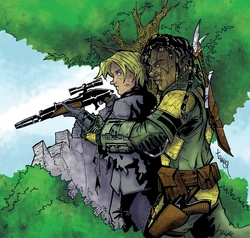
Novoc Vevut raised his adopted son Ghes Orade on Mandalore in the aftermath of the Yuuzhan Vong War.
After the war with the Yuuzhan Vong came to a close, and the defeated Vong came to live on the sentient planet Zonama Sekot,[27] the battle-devastated planet of Mandalore was one of many planets that did not join the recently formed, multi-governmental political conglomerate, the Galactic Federation of Free Alliances. Mandalore was also one of the many worlds that did not receive aid from the new Galactic Alliance,[27] despite its role in assisting the New Republic,[4] and defending several worlds threatened by the Vong invaders.[14] As such, the slow process of revitalizing Mandalore was left to the Mandalorian people alone, a task that spanned close to ten years.[3]
By 40 ABY, much of the physical damage that the Yuuzhan Vong had wreaked on Mandalore had healed. The bodies of the dead, Mandalorian and Vong alike, had been buried, and most of the damage to buildings and structures had been repaired. The hundred-meter-tall tower of MandalMotors' headquarters in Keldabe was still adorned with several scars, however, and the majority of the woodland that surrounded Mandalore's capital city remained flattened. Perhaps worst of all the issues plaguing Mandalore on its road to recovery were the food shortages that came as a result of the farmland that had been poisoned by the Vong, and the severely reduced population. These were two issues that were brought before a meeting of Mandalorian clan chieftains at MandalMotors Hall in Keldabe. Presiding over the gathering of clan leaders and corporate executives, Mand'alor Boba Fett agreed to an idea put forth by the Mandalorian soldier Graad to decree a recall of two million Mandalorians living offworld throughout the galaxy to return to Mandalore in order to bolster the population. The Carid clan took up the responsibility of allocating Mandalore's abandoned fallow farmland to any Mandalorian arrivals from offworld who wished to claim ownership. Fett also contributed several million credits to a fund for importing what food and supplies were necessary from offworld until a level of self-sufficiency could again be reached, a fund into which the head of MandalMotors, Jir Yomaget, promised to donate half of the company's profits.[3]
Heeding the call of the Mand'alor, Mandalorians from planets all across the galaxy journeyed to Mandalore in droves, reclaiming abandoned farmland and bringing their varied expertise to the Mandalorian homeworld.[7] Two such Mandalorians—one with a background as a geologist and the other as minerals engineer—decided to scan a region of Mandalore that had been significantly damaged by the Yuuzhan Vong while on orbital approach, and upon further inspection, discovered a new lode of beskar iron deep within the planet that the Galactic Empire had missed so many years prior, only to be exposed by the Vong's attack. Located a few hundred kilometers north of the remote town of Enceri, the beskar find wasn't located on land owned by any one Mandalorian, and thus the Mand'alor declared that the fresh ore would be used a resource for all of Mandalore: half would be sold offworld for profit, and half would be kept for domestic armament. The newly discovered beskar enabled the start of a new era of economic resurgence on Mandalore. When news of Mandalore's beskar discovery became publicly known, the Verpine of Roche declared their interest in purchasing an amount of the powerful metal, but also made mention of the Verpine hive's concerns about potential Mandalorian aggression while their representative Sass Sikili was in talks with Boba Fett. Fett was able to quell the Verpine's fears by offering a treaty between Mandalore and Roche, wherein a pact of nonaggression was made, and a mutual aid system was established: Mandalore would provide martial service and beskar iron, in exchange for exclusive Verpine technology, and access to Verpine technical facilities. The Verpine hive accepted, and the resulting alliance only served to strengthen Mandalore's economy.[3]
Second Galactic Civil War[]
- "Mandalore has no position on the current war, and there'll be no division over it. Anyone who wants to sell their services individually to either side—that's your business. But not in Mandalore's name."
- ―Boba Fett
As Mandalore's economy and infrastructure flourished, the outside galaxy was in the midst of a division that quickly escalated into the Second Galactic Civil War, as the Galactic Alliance faced off against the Corellian-led Confederation. In order to better focus on Mandalore's restoration, Boba Fett declared the planet to be neutral in the conflict, though he also recognized the importance of mercenary work in providing needed credits to some Mandalorian residents, and thus did not interfere with the right of individuals to take up personal contracts. Due to Mandalore's recent treaty with Roche, however, Mandalorians declined work from Verpine disfavored Kem Stor Ai, and punitively bombed several factories on Murkhana after the planet abused and ignored Verpine technological patents. The bombing raid on Murkhana was also a display of Mandalore's new Bes'uliik starfighters, designed and constructed by MandalMotors using the new beskar lodes;[3] several Bes'uliik fighters became part of Mandalore's defense fleet, in addition to more heavily armed and armored Tra'kad-class assault ships.[7] By the Mand'alor's proclamation, Bes'uliik fighters were to be available for sale and export to all interested parties, regardless of side in the current civil war, though he stipulated that Jacen Solo—having recently killed Fett's daughter, Ailyn Vel—would have to come to Mandalore personally to deal for the Republic. The government of Bothawui sent a formal offer to Mandalore to acquire a squadron of Bes'uliik fighters, and offered a larger premium to gain exclusive purchasing rights to the vessel. The Bothans also offered twenty million credits per month for the services of a Mandalorian assault fleet and additional infantry forces.[3]
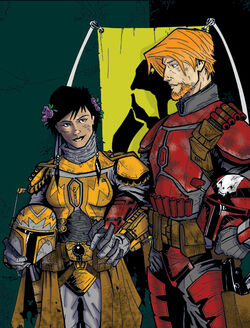
Mandalorians Mirta Gev and Ghes Orade were married on Mandalore during the galactic civil war.
Despite Mandalore's state of planetary neutrality,[3] when Boba Fett was contacted by Imperial Admiral Natasi Daala just prior to the Second Battle of Fondor, Fett agreed to assemble a group of supercommando mercenaries in order to aid Grand Admiral Gilad Pellaeon. When Pellaeon was killed by the Sith apprentice Tahiri Veila, Fett and his commandos attacked and took control of Pellaeon's flagship, Bloodfin, wounding both Veila and her Sith Lord master, Darth Caedus—formerly Jacen Solo. Though the injured Sith managed to escape, the battle at Fondor was a victory for the Galactic Alliance and Imperial Remnant-comprised "Jedi Coalition." Soon after, Fett's granddaughter, Mirta Gev was married to her lover Ghes Orade on Mandalore, and a wedding reception was held in Keldabe.[7]
The Mandalorians were later called to defend the Verpine asteroid Nickel One against an attack by Imperial Remnant forces loyal to Darth Caedus, as part of Mandalore's treaty with Roche. Fett and his soldiers were on hand during the Jedi Coalition's assault on Caedus, even participating in killing several Imperial Moffs loyal to the Sith Lord. But in retaliation for the Mandalorians' participation, Caedus sent what ships were left of the Galactic Alliance Fifth Fleet to attack Mandalore, and released a nanovirus across the surface, engineered via blood stolen from Mirta Gev to kill any member of the Fett clan who stepped foot on the world. However, unknown to the Imperials who used a modified version of the Clone Wars–era FG36 virus,[50] much of Mandalore's populace had been inoculated for the base nanovirus years earlier during the reign of Mand'alor Fenn Shysa by the formerly Separatist scientist Ovolot Qail Uthan, a cure which was communicable by both air and touch, and was transmitted from parent to child.[6]
Sith–Imperial War[]
- "Yaga Auchs is Mandalore now."
"Heard that. Keeping everyone on planet, clear of conflicts. Rebuilding." - ―Tes Vevec and Hondo Karr
By the first year of the Sith–Imperial War, Chernan Ordo had become the new Mand'alor. But while employed by the Galactic Alliance to defend the planet Botajef from the forces of the Fel Empire, Ordo was betrayed by his trusted soldier, Yaga Auchs. Auchs pulled the Mandalorians out of battle, and with all but Hondo Karr, the man who discovered Auchs in the act, unaware of his betrayal, Auchs claimed the title of Mand'alor for himself. With that new authority, he ordered the Mandalorians back to Mandalore and ended the alliance with the Galactic Alliance, and where they would remain under the premise of rebuilding,[51] just as Boba Fett had done years earlier. Unlike Fett,[3] Auchs' decree came at the order of the master he secretly served, who desired the Mandalorians remain out of the war.[51]
Inhabitants[]
- "In five millennia, the Mandalorians fought with and against a thousand armies on a thousand worlds. They learned to speak as many languages and absorbed weapons technology and tactics from every war. And yet, despite the overwhelming influence of alien cultures, and the absence of a true homeworld and even species, their own language not only survived but changed little, their way of life and their philosophy remained untouched, and their ideals and sense of family, of identify, of nation, were only strengthened."
- ―Mandalorians: Identity and Language
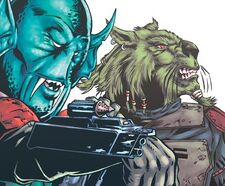
Mandalorians of many different species lived on Mandalore, including Mandallians and Togorians.
Since the Taung first arrived from Roon, Mandalore has been dominated by the Mandalorian people. Over time, the planet became the political center of Mandalorian space, and the one true homeworld acknowledged by the often nomadic warriors.[1] However, as the Mandalorians were spread out in communities across the galaxy, many Mandalorians were not born on Mandalore, and had never seen the planet during their lifetime.[10] Though the term "Mandalorian" was originally used by the Taung to describe themselves,[23] by the end of the Great Sith War, the Mandalorians began accepting beings of other races into their fold, viewing those who joined them on equal footing to those who had been born into the culture, and transforming what it meant to be a Mandalorian.[14] Having become a mixed group of beings from numerous worlds and species, those who considered themselves Mandalorian were bound by a single, unifying culture as defined by the Resol'nare.[10]
Never a densely populated world, Mandalore maintained a population that hovered around four million individuals throughout much of its history.[7] Due to its sparse population, land outside of what urban zones there were was free for an individual to settle at their choosing, so long as it was not already occupied.[9] Despite the large place mercenary work held in the culture honored by Mandalore's warrior clans,[14] many Mandalorians took up non-martial occupations on Mandalore. Several toiled in workshops and factories,[10] while others tended bars, ran shops, and worked as doctors, veterinarians,[3][6] and in New Mandalorian society, even formal teachers.[11] As Mandalore was the only known world[3]—in addition to its moon, Concordia,[18]—to possess the element beskar,[3] Mandalorians have mined Mandalore for the nearly indestructible metal for generations, with Mandalorian blacksmiths passing down the closely-guarded secrets of how to manipulate beskar through the ages.[14]
Government and economy[]
- "You can't rule Mandalorians. You just make sensible suggestions they want to follow. And since when have Mandalorians needed to be told what makes sense?"
- ―Boba Fett
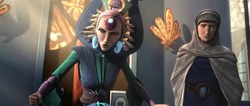
New Mandalorian leaders, Duchess Satine Kryze and Senator Tal Merrik
The ultimate authority on Mandalore, and in the greater Mandalorian culture, rested with the Mand'alor.[10] A position that was non-hereditary, and considered a combination of general, king, and warlord,[52] the word Mand'alor meant "sole ruler,"[22] and was the closest to an official head of state the Mandalorian warrior clans traditionally had.[10] Beneath the Mand'alor, were the numerous leaders of the many Mandalorian clans. These clan chieftains functioned as an unofficial senate, and would gather—often alongside the current Mand'alor—to make decisions affecting Mandalore.[3][12] The New Mandalorians, however, had a different system of government. More centralized and bureaucratic[11] than the loose affiliation of Mandalore's warrior clans,[6] the New Mandalorian government was comprised of a Ruling Council of ministers, led by a Prime Minister.[11] The Prime Minister was also subservient[2] the New Mandalorians' own Mand'alor, chosen in opposition to those who ruled the warrior clans.[30]
For much of Mandalore's history, Mandalore's planetary economy has been driven by the MandalMotors company,[15] which based its headquarters in Keldabe, Mandalore's capital city.[3] Famous for its vehicle designs, MandalMotors produced such starships as the StarViper-class attack ship,[14] the Bes'uliik-class starfighter,[3] and the Keldabe-class battleship, in addition to Canderous-class assault tanks[53] and Buirk'alor-class airspeeders,[54] among many other designs.[14] During the New Mandalorians' period of ascendancy on Mandalore,[1] Republic trade routes were established and New Mandalorian society enjoyed food and supplies from Republic benefactors. However, once the New Mandalorian government established Mandalore's neutral role during the Clone Wars, the flow of goods was stemmed as the trade routes were closed.[11] Despite a history of being marginalized,[15] Mandalore managed to carve out a niche in the galactic economy with beskar iron, which was one of the strongest metals known to science, and among the most valuable metals on the galactic market.[3] On the individual level, Mandalorian mercenaries and bounty hunters were one of Mandalore's largest exports,[1] and Mandalorian weaponsmiths, veterinarians, metallurgists,[3] and shop keepers could earn a sustainable living via their trade.[6]
Behind the scenes[]
The origins of Mandalore can be found in an early story concept for Star Wars: Episode V The Empire Strikes Back. A group of armored supercommandos from the Mandalore system were conceived and designed for the film, but the idea was later dropped and the concept art for their armor was reassigned to Boba Fett.[55] Mandalore and the idea of the Mandalorian supercommandos remained, however, and the world, the soldiers, and the name were brought into Star Wars Legends in the 1982 Marvel comic, Star Wars (1977) 68.[16]
Many aspects of Mandalore, including its environment, government, and population, were both created and expanded upon in the Republic and Imperial Commando novel series by author Karen Traviss, where the planet was one of several important locations.[6][9][12] Traviss made further contributions to fleshing out the Mandalorian world during the multi-author series, Star Wars: Legacy of the Force.[3][7] Numerous other details concerning Mandalore were added by Traviss' Star Wars Insider article, The Mandalorians: People and Culture,[10] along with Abel G. Peña's earlier article, The History of the Mandalorians.[14]

Mandalore as it appears in The Essential Atlas
With the airing of a trio of episodes—The Mandalore Plot, Voyage of Temptation, and Duchess of Mandalore—in the second season of the Star Wars: The Clone Wars television series, a significantly different portrayal of Mandalore was introduced.[34] This version of Mandalore, first alluded to in the The Art of Star Wars: The Clone Wars artbook,[56] was a barren world, covered in a blasted flat desert of white sand that was uninhabitable outside of sealed cube cities populated by staunch pacifists,[19] and whose capital was a domed city called Sundari.[37] Despite the radical departure from established canon the television series made use of for Mandalore,[34] the later reference books The Essential Atlas and the Star Wars: The Clone Wars: New Battlefronts: The Visual Guide made several retcons that effectively integrated the new version of Mandalore with prior, more arboreal iterations, stating collectively that the barren desert is in fact only one aspect of Mandalore's[18] varied ecosystems, and the previously established jungles and forests were still accepted as canon.[1]
The development team behind the Star Wars: The Clone Wars series also designed a specific color scheme for Mandalorian technology to set it apart from the equipment used by the series' other factions. As opposed to the Republic and Separatists, whose technology could typically be seen colored in hues of blue or green, respectively, technology on Mandalore was given a uniquely amber coloration.[34]
